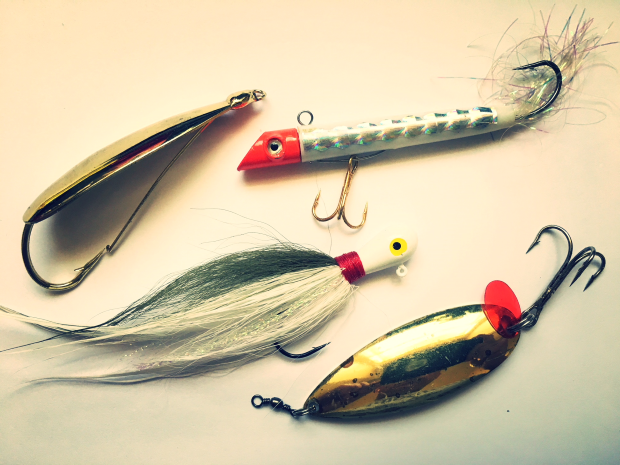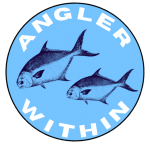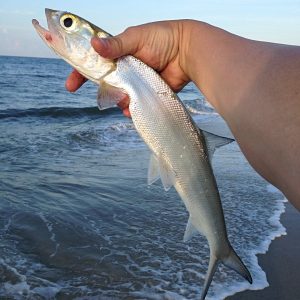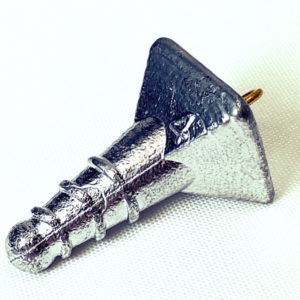*As an Amazon Associate I earn from qualifying purchases.

Most anglers gearing up to go surf fishing for the first time are not targeting any specific species of fish. If that’s the case with you, then it’s best to build some flexibility into your setup.
Even seasoned surf fishermen targeting certain species, usually stay prepared for whatever might be running the beach on a given outing.
Following is a beginners surf fishing supply list that should give you a great start. I know it seems like a lot of gear, but it’s really not too bad. Besides your fishing pole, most everything else will fit nicely into a 5 gallon bucket.
- Fishing Rod and Reel
- Bait
- License
- Hooks
- Water and Other Drinks
- Hat
- Sunglasses
- Sinkers
- Sunscreen
- Knife
- Tackle Bag or Bucket
- Sand Spikes
- Pliers
- Fishing Rigs
- Leader Material
- Lures
- Towel
- Measuring Device
1. Surf Fishing Rod and Reel
Of course the number 1 thing on the list is a rod and reel. Without that, you aren’t going to be doing much surf fishing. It doesn’t really have to be a rod and reel set up specifically for surf fishing. It can be almost whatever you have on hand. I started out with an Abu Garcia Ambassadeur 5000 reel on a 6 foot bass rod.
The true limiting factors of most non-surf equipment is generally in how heavy a lure the rod is rated to throw and it’s line capacity.
In the surf, you’ll want to be able to handle a minimum of 1 ounce weights. Really, 3 ounces is preferred. If your rod is undersized, that’s OK. Just take it easy when casting so that you don’t snap your rod.
Ideally, you’ll purchase a surf fishing rod and a reel that can hold a couple hundred yards of line. I have a whole article about how to choose a surf rod here – https://anglerwithin.com/top-9-criteria-to-evaluate-when-choosing-a-surf-rod/
2. Bait

Coming in at number 2 is some sort of bait, whether that be fresh or frozen. It’s sure hard to beat the combination of convenience and effectiveness of FRESH dead shrimp. You can purchase fresh dead shrimp at a bait shop, or you can get it in the seafood section of a grocery store.
Bait shops usually have some shrimp that have died in the tank which they then scoop into a foam container and refrigerate. They sell this as “fresh dead shrimp”. Don’t bother with frozen shrimp. While frozen will work, it’s not nearly as effective as fresh.
Other options are squid, frozen cigar minnows, or Fishbites. I always carry Fishbites with me as a backup in case I run out of bait. They are very effective for surf fishing, and you can shove a couple packs in your tackle back so that you are always prepared. If you’ve never tried them, check them out at https://fishbites.com/
From here on, my list is in no particular order.
3. License
Although I don’t get checked often for compliance, I have been checked. In fact, I had a law enforcement officer sneak up on us at Fort Pickens, Florida. He glided his boat onto the sand right in front of us in pitch black dark. He was on top of us before I knew anyone was there. We were 100% legal, so no issues. Just do the right thing and buy a license and follow any applicable game laws.
4. Hooks
As a beginner, I would just keep it simple. Literally all you need are some quality 1/0 circle hooks. They will catch most things you are likely to snag off the beach. A quality 1/0 circle hook is capable of bringing in a rather large fish from the surf. 2/0 or #1 circle hooks are great options as well. Mustad Demon Perfect Circle hooks are a solid option.
If you plan to throw a second rod out for a big fish opportunity, you might want to buy a pack of larger hooks for that.
5. Water and Other Drinks
Water, or at least something to drink, should be very high on your list. I prefer water as it can serve double duty to rinse off reels in case they get dropped in the sand.
A good tactic is to take a couple frozen 1 liter water bottles. You can drink them as they thaw. And, if you end up keeping a fish, you can use the liter bottles of ice to cool them down.
6. Hat
Just use whatever hat you like, but take a hat. I tend to wear a boonie style hat similar to what the Army uses. Hat’s are both great for protecting your face, as well as knocking a lot of the sun off your eyes.
7. Sunglasses
Not a lot to say about sunglasses. You’ll never regret bringing a good pair of polarized sunglasses to the beach.
8. Sinkers
Sinker selection can be pretty straightforward. All you have to do is purchase several sizes from 1 to 4 ounces. Make sure to get pyramid sinkers. Pyramid weights are much better at holding onto the sandy ocean floor than other options.
If your rod is strong enough to cast it, a 3 ounce sinker is a great all around size 90% of the time. You can get by with 1 or 2 ounces if the current is light.
9. Sunscreen
If you fish much past the first couple hours of daylight, you must bring sunscreen. Pick your favorite brand and SPF and throw it in with your tackle.
10. Knife
A knife will be used to cut bait and fishing line, among other things. You’ll also undoubtedly catch small fish that you can use your knife to turn into great fresh cut bait.
Just be sure you have some sort of knife with you when you go surf fishing. And, don’t forget to rinse your knife off REALLY good with freshwater after your outing. The same goes for any of your other equipment as well.
11. Tackle Bag or Bucket
Before graduating to a surf cart, my personal preference was a cheap backpack combined with a 5 gallon bucket. There is no need to spend a bunch of money on a surf cart right out the gate. All you need is something that will help you get the other surf fishing items listed here to the beach.
The beauty of a bucket is that if an unexpected wave reaches up further than you expect, your equipment will still be nice and dry. A bucket can also double as a makeshift chair.
12. Sand Spikes a.k.a. Rod Holders
When it comes to sand spikes, there is a trade off. Many PVC sand spikes sold in bait shops are thin walled. The upside to those are that they are very lightweight. The downside is that the pointy end is really bad about bending if you try to beat it into the ground.
You can make a more durable PVC rod holder from supplies purchased at the hardware store. Homemade surf spikes are both cheaper and more durable, but they are also heavier.
My recommendation is to buy a thin walled sand spike and be gentle with it. Just make sure you set your drag loose! Otherwise your spike could get yanked out of the sand by a big fish and bye bye fishing rod. If you end up not liking the thin walled PVC rod holder, you can use it as a pattern to build your own, or you can upgrade to a set of aluminum rod holders.
Aluminum rod spikes are a big step up from PVC sand spikes in both quality and price.

* Click image above to view prices on Amazon
13. Needle Nosed Pliers
I consider needle nosed pliers to be a necessity for any type of fishing. Pliers can be used for many things, most notably removing hooks from fish.
Pliers can also be used for tossing saltwater catfish back into the sea. Trust me, you don’t want to get poked by a hardhead catfish.
My preference is a set of modern fishing pliers with carbide cutters. These run around $25. But, a cheap pair of pliers is just fine as well. The saltwater is going to corrode them eventually anyway.
14. Surf Fishing Rigs or Supplies To Tie Rigs
I think it’s hard for a new surf fisherman to go wrong with just using 2 hook bottom rigs, or pompano rigs. When buying pre-tied pompano rigs, try to get the ones with circle hooks. I don’t prefer those made with kahle hooks.
If you hold off on buying your fishing rigs until you get to the beach, you’ll have a lot more options. Most inland stores don’t come close to the options found in tackle shops along the coast.
A better option is to tie your own rigs using supplies you bought ahead of time. All you need is some line, hooks, snap swivels, and maybe some plastic beads.
Bama Beach Bum has a good video, that I linked to below, showing how to tie pompano rigs for surf fishing.
15. Thick Leader Material
You will also want to bring some heavy mono or flourocarbon to be used as leader material, in case you run into some toothy critters. Nothing is more frustrating than having constant bites, but you can’t even see what it is biting, before it chops your rig off.
In most cases, you don’t want wire, as it spooks off a lot of what you’re after. Instead, get some 25 to 40 pound clear line which will get you a lot more bites than wire. You’ll need the thick leader if you get into some Spanish mackerel or bluefish action.
16. Lures

Besides bait, I like to also include a few lures in my supplies, such as spoons or Gotcha jigs. Simply tie these on to a 2 to 3 foot section of heavy mono leader, with a non shiny swivel at the other end. You can then tie the swivel onto your mainline rather quickly when needed.
A spoon connected to a heavy mono leader is a very effective tool to fire at passing schools of fish. This can be a blast if a large school of Spanish mackerel, bluefish, or ladyfish make their way along the beach in front of you.
17. Rag or Towel
A towel is a nice addition to your surf fishing gear. Not only is it handy for wiping things down, it can also be used to aid in unhooking a foul hooked bird. Yep, that can happen. Here’s just a little guy that hooked himself on a deep sea trip. Imagine if that were a pelican you had to deal with.

You also may find yourself wanting to take a quick dip. After all you have the world’s largest pool right in front of you.
18. Measuring Device
If you have any intention of keeping fish, you’ll want to include something to measure your catch with. I usually carry a cloth tape like seamstresses use. They take up almost no room and weigh nothing. The saltwater also does not bother them. If it’s a close measurement, I release the catch for something bigger.
Conclusion
You should now have a good idea of what supplies you need in order to have a successful surf fishing outing.
I’ll leave you with the best beginner tip I can think of. And, that is to go early in the morning, or late in the day. During times of low light, you can successfully fish in the first trough off the beach. You don’t have to try to cast beyond that first sandbar. All kinds of fish come up close in low light situations. Chunk out a piece of fresh dead shrimp and hold on! It’s almost guaranteed you will get bites.
If you’d like to know more about targeting a specific species from the beach, you might be interested in this article – https://anglerwithin.com/how-to-catch-pompano-from-the-surf/
Good Luck!
Augustus Clay



